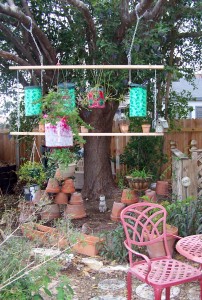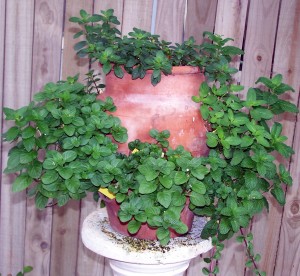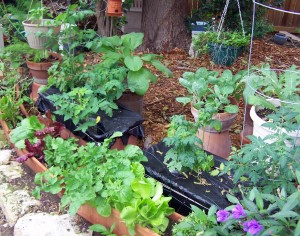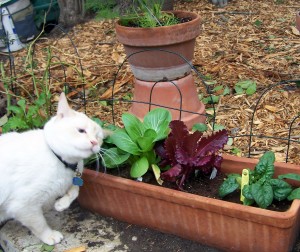 One of the best things about buying a house and retiring from the military was being able to feel free to actually get serious about a garden. I went through a phase of planting roses many of which have thrived and survived and a long project to rip out the existing lawn, back and front, and put in xerioscape plants. The back yard was the place that I put the most into, though. Because of the layout of the rooms and the windows in them, the back was the part I looked at the most. And because of the peculiar soil composition a foot or so of heavy, dense clay laid down over an impermeable layer of caliche which apparently goes all the way to the core of the earth getting certain things to thrive and grow in it has been a challenge. Really, if I had known then what I do now, I would have hired someone to come in with a bulldozer, scrape up all the topsoil and replace it with Miracle-gro. But I made do with putting a lot of things in pots, and I had quite a nice little garden going, until a pair of disasters. The first were the two rambunctious young dogs that my daughter fostered for a couple of months. They were whirling balls of destruction … and by the time we found permanent homes for them, they uprooted half a dozen of the potted and planted specimens and dug holes everywhere. Then a hard and prolonged freeze in January, 2010 pretty well finished off everything else.
One of the best things about buying a house and retiring from the military was being able to feel free to actually get serious about a garden. I went through a phase of planting roses many of which have thrived and survived and a long project to rip out the existing lawn, back and front, and put in xerioscape plants. The back yard was the place that I put the most into, though. Because of the layout of the rooms and the windows in them, the back was the part I looked at the most. And because of the peculiar soil composition a foot or so of heavy, dense clay laid down over an impermeable layer of caliche which apparently goes all the way to the core of the earth getting certain things to thrive and grow in it has been a challenge. Really, if I had known then what I do now, I would have hired someone to come in with a bulldozer, scrape up all the topsoil and replace it with Miracle-gro. But I made do with putting a lot of things in pots, and I had quite a nice little garden going, until a pair of disasters. The first were the two rambunctious young dogs that my daughter fostered for a couple of months. They were whirling balls of destruction … and by the time we found permanent homes for them, they uprooted half a dozen of the potted and planted specimens and dug holes everywhere. Then a hard and prolonged freeze in January, 2010 pretty well finished off everything else.
Beginning last spring, I had to start pretty much from scratch, at least as far as the potted plants were concerned. Bit by bit, half a dozen at a time; a trek up to Wimberley for Market Days, and to the San Antonio Herb Market to replace the exotics and the herbs, a start on filling the dozens and dozens of empty pots. Late last spring, my daughter bought a number of topsy-turvy tomato and pepper planters, marked very well down at the grocery store. I had never had much luck growing tomatoes in San Antonio; really, sometimes it seemed like it was a curse or something. But they grew well in the topsy-turvys last year … so this year, we planted them all again. We had an idea, from seeing one in a neighbor’s yard, to build a frame so as to hang a row of them from branches of the big mulberry tree that shades half of the back yard. The frame is two lengths of 2×4, one below the other and connected by chains, and hanging from another set of chains, suspended between two high branches. 
Then, there were the three earth-box planters that we found, put out for the trash. Apparently, they are supposed to be the absolute bee’s knees when it comes to growing veggies. We hauled them home, looked up the instruction manual on line, and now two of them are full of tomatoes and the third with zucchini and cucumbers. I also had one of those special pots for growing strawberries with seven or eight little openings along the sides, which never grew strawberries or much of anything very well, as the soil leaked out before the roots of the plants grew enough to stabilize it all. We had the notion to plant it with various kinds of mint which grows like a weed anyway and cut bits of coir to put around the base of each plant to keep the soil in place. This looks to be working well; this week, we can hardly see the sides of the pot for all the mint.
I also had a number of long rectangular pots now they are filled with thriving lettuce and salad greens. It would be fantastic to keep salad greens going for as long as possible: nothing beats the taste of fresh-picked greens. The long planters and the earth-boxes are mostly arranged on the ground underneath the hanging frame, so that they can all be watered at once, and water overflowing from the uppermost will drip down on the lower.
A couple of weeks ago, one of our neighbors were having some trees heavily trimmed. Out in front of the house, there was one of those wood-chippers and a small covered truck to haul the chipped wood in and we got the attention of the crew boss and asked if they would give us some mulch. He said sure but warned us that the stuff came off the back of the truck two or three cubic yards at a time. Were we sure we wanted that much? Oh, yes we were. There was a veritable Matterhorn of finely-chopped fresh wood mulch in our driveway by that afternoon. We could have used even more, but my daughter said flatly that her back couldn’t have handled another couple of wheel-barrow loads. Just about every one of the planting beds, front and back, is now covered with three or four inches of mulch, and looks a thousand times better than it did after the dogs and the frost got done with everything.
In one big empty patch, where I used to have a cluster of potted plants, I decided that I wanted a mixture of salvia which does thrive in clay soil, fortunately and some artichokes, which are only a species of thistle. How hard could it be? I love artichokes, and being able to pick them fresh from the garden would be fantastic. So a little salvia there, some artichokes, cardoon and lambs’ ear there … and maybe at last I can fill in that bare patch. The surviving roses which were all from the Antique Rose Emporium outlet, are heavy with clusters of buds. We might even have something spectacular from the roses at last.
And just this very morning, we were talking about building a raised bed from the treated timbers intended to construct decks with. It wouldn’t be very hard at all, to build one to fit into the back corner of the yard which is so full of little bits of brick and concrete rubble left from constructing the house that I have despaired of getting anything to grow there. Something long and relatively narrow, rather like the earth-boxes, but several times bigger, something that we could even cover with a plastic sheet in the winter, to keep stuff going … now, that will have to wait for another year. Right now, I’ve got the place back to where I enjoy looking at it, again.

(Sammy the three-legged flame-point Siamese says, “Yes, yes, these will make most excellent barfs!”)
4 thoughts on “Reviving the Garden”
Comments are closed.
Sgt – you have far more patience than me in re: gardening. I suppose some could say, sitting out for hours with a spade or pulling weeds, that it could be therapeutic.
But then you solved most of that with potted plants (and poor soil!)
How did you pick San Antonio once you left the Air Force? Was that your last station (Lackland, isn’t it?)
A lot of retirees seems to stay at their last station – San Diego has once of the highest concentrations of ex Navy people –
Last assignment was at the Combat Camera detachment at Lackland,Bill. It was actually third down of my choices: I had wanted very much to go back to Hill AFB, Utah, and the second choice was Kirtland AFB. I loved Utah, and liked Albuquerque very much … but. Oh, well. I bought the house, had the daughter in high school, part-timed at the local public radio station, and just decided I would stay put. Worked out for the best, actually.
When you’ve got poor soil & even when you don’t, the magic word is *compost* (otherwise known as black gold to gardeners). Raised beds filled with a mix of compost & good topsoil will make your plants very happy if you want something bigger than individual pots. I’ve heard that spreading compost over the top of bad soil will eventually create a layer of good soil for plants. Not sure if it will help with drainage problems with the caliche though.
Here in Maryland people rake & bag their leaves every fall & the state takes them, mulches them & makes Leaf-Gro compost that they sell to garden centers who sell to the public. Since I’m cheap & lazy, I rake my fall leaves into my driveway, run the mulching mower over them a few times & spread the results over my garden beds to make ‘lazy man’s compost’ or leaf mulch. That also removes any need to go & buy wood mulch every spring. The leaves break down over the summer & the beds are ready for their new layer of mulch by fall. The plants are very happy & when I dig in my beds I find lots of happy earthworms (plus the weeds but that’s another story).
A warning about the wood chips you put on your beds – the mulch you buy from a nursery is made from justthe bark. Wood chip mulch will use up nitrogen from the soil as it breaks down so you’ll need to add some fertilizer to your beds to make up for the nitrogen loss. I like to grow lettuce in containers on my patio – so the rabbits & other varmints don’t get it all before I do.
Hi, Badger – yep, we’ve played around with improving the soul with digging in sand and mulch, and layering dead leaves on top. I figure in another couple of decades this will work out just fine! The topsoil around here is really, really nasty, though. Wet, it’s pure clay. Dry, it’s like adobe brick. Some people get around it by doing native plants. The raised beds and filled with good soil are the only thing to work more or less from day one.